ADSactly Art History - The Reign of Alexander The Great as a Catalyst For The Impact Of Greek Culture on the Areas of the Middle East
The Reign of Alexander The Great as a Catalyst For The Impact Of Greek Culture on the Areas of the Middle East
Both the time of Alexander and the Hellenistic dynasties, which took power after his death, is marked by a significant change in thinking about art. In some respects, the idea is directed towards the ostentatious expression of military power. The impact of Hellenization has left its mark on the art and architecture of the newly conquered territories in the east. A characteristic feature of the art of the period in question is the surprising spread of twin styles in very spatially and temporally distant places: from Persia to India, Siberia; from V to the I century BC. Intensive migrations of peoples favoured this tendency. This is his influence and authority on the art of Persia, Mesopotamia and Bactria.
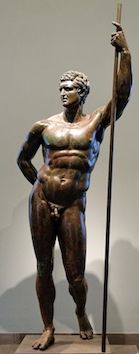
Seleucid prince, perhaps Attalus II of Pergamon, 3rd-2nd centuries BC, Author:Marie-Lan Nguyen License:Public Domain
Persia
Persian art was heavily influenced by the Greek, as we can see on the examples of coins and seals from that area. While the classic shapes of figures and performance materials are preserved, the detail has changed: the horses in the hunting scenes received the Greek appearance (sharp noses, raised mane). To this day, there are not many examples of Seleucid sculptures. An example of a preserved sculpture is the representation of Heracles in the rock ridge at Behistun. Heracles was locally assimilated with god Verethragna (Boardman, 1995: 79).
In search of Hellenistic influences on the sculpture of the Middle East, attention should be paid to architecture (although urban planning and engineering were often un-greek). Highly Hellenized areas were centers such as Hatra, Ashur, even Palmira and Syria. They were the core of the Seleucid kingdom, and the Parthian kings declared Philo-Hellenism. Greek ornamental art was present throughout the entire Persian territory. The Parthians managed to separate the decorative and constructional function of the columns, used them to decorate the facades, thus disturbing the proportions of the shaft and the capitol - an example of the facade of the temple in Uruk (pictured).
Another Greek influence is plant ornaments with acanthus leaves, often in unprecedented functions, for example as a frieze element. The use of these Greek elements, however, was subordinated to local customs in design.

Antiochus I of Commagene, shaking hands with Heracles, 70–38 BC, Arsameia, Author:Klaus-Peter Simon License:CC BY-SA 3.0
In the western regions, the rulers of Commagene worshiped Persian deities, presenting them in a typical Greek outfit, combining Eastern formalism (representations of kings) with classical sculpture (depictions of deities). Greek Heracles (here integrated with the Persian Verethragna) is depicted naked with anatomy resembling a classic style. The Parthian artists showed the local deities with the characteristic of them frontality, and their costumes have a strongly expressive trait, originally created to give the shape of the body underneath, and now simplified, in the form resembling a rope's ridge. The frontalism of the figures seems to be somewhat strange and can be explained by their role: they impose divine authority on subjects.

Marble head of a Parthian queen, late 1st century B.C.E., from Susa, Iran Bastan Museum, Tehran, Author:Darafsh License:CC BY-SA 3.0

Coin of Andragoras, the last Seleucid satrap of Parthia. He proclaimed independence around 250 BC, Author:http://www.cngcoins.com License:CC BY-SA 3.0
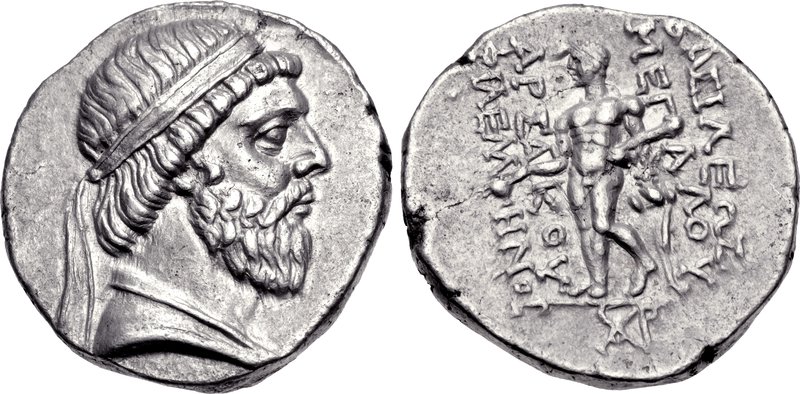
Coin of Mithridates I (R. 171–138 BC). The reverse shows Heracles, Author:http://www.cngcoins.com License:CC BY-SA 3.0

Silver bowl with figures set in a landscape of trees,Tibet 1st/2nd cent. AD (?).(After DCAA),Author:https://erenow.com
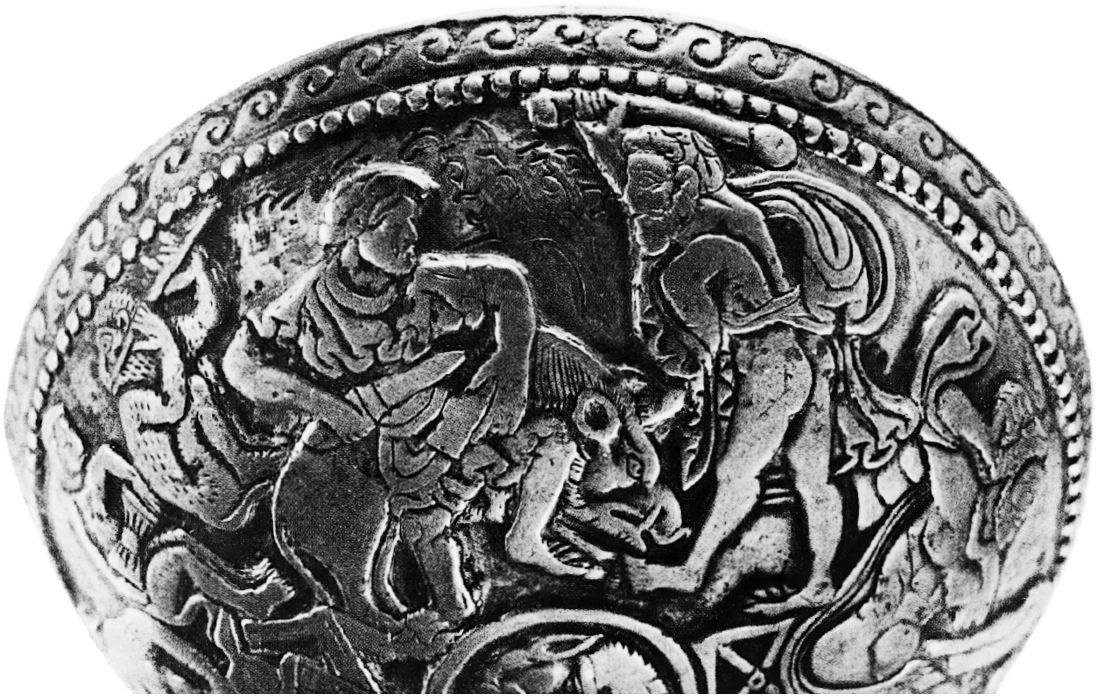
Silver cup with classicizing scenes including Herakles attacking a seated man. 1st/2nd cent. AD (?) St Petersburg, Hermitage Museum, Author:https://erenow.com

Map of the Greco-Bactrian at its maximum extent, circa 180 BC, Author: World Imaging License:CC BY-SA 3.0
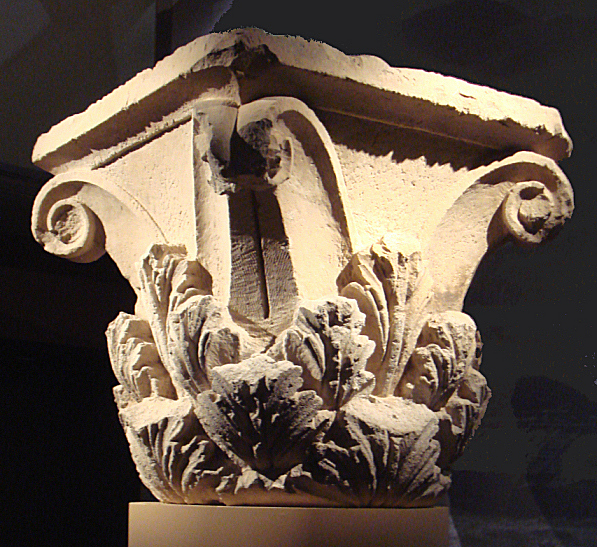
Corinthian capital, found at Ai-Khanoum, 2nd century BC, Author: World Imaging License:public domain

Greek and Indian flame palmettes. Left: Flame palmette at Didyma, Ionia, c.300 BCE. Middle: Pataliputra capital, India, 3rd c.BCE. Right: Ashoka's Diamond throne, Bodh Gaya, India, 250 BCE, Author: Radomil License:CC BY-SA 3.0
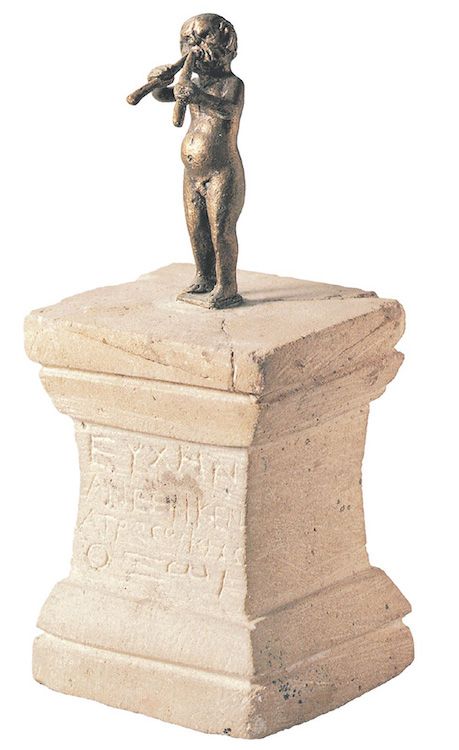
Votive altar with Marsyas, dedicated to the River-God Oxus, from Taḵt-e sangin, Author: Boardman, Diffusion of Classical Art License:public domain

Silver gilt phaleron from Novouzensk, featuring a war elephant with turreted howdah and a ketos on the saddle cloth, St Petersburg, Hermitage Museum, Author: https://erenow.com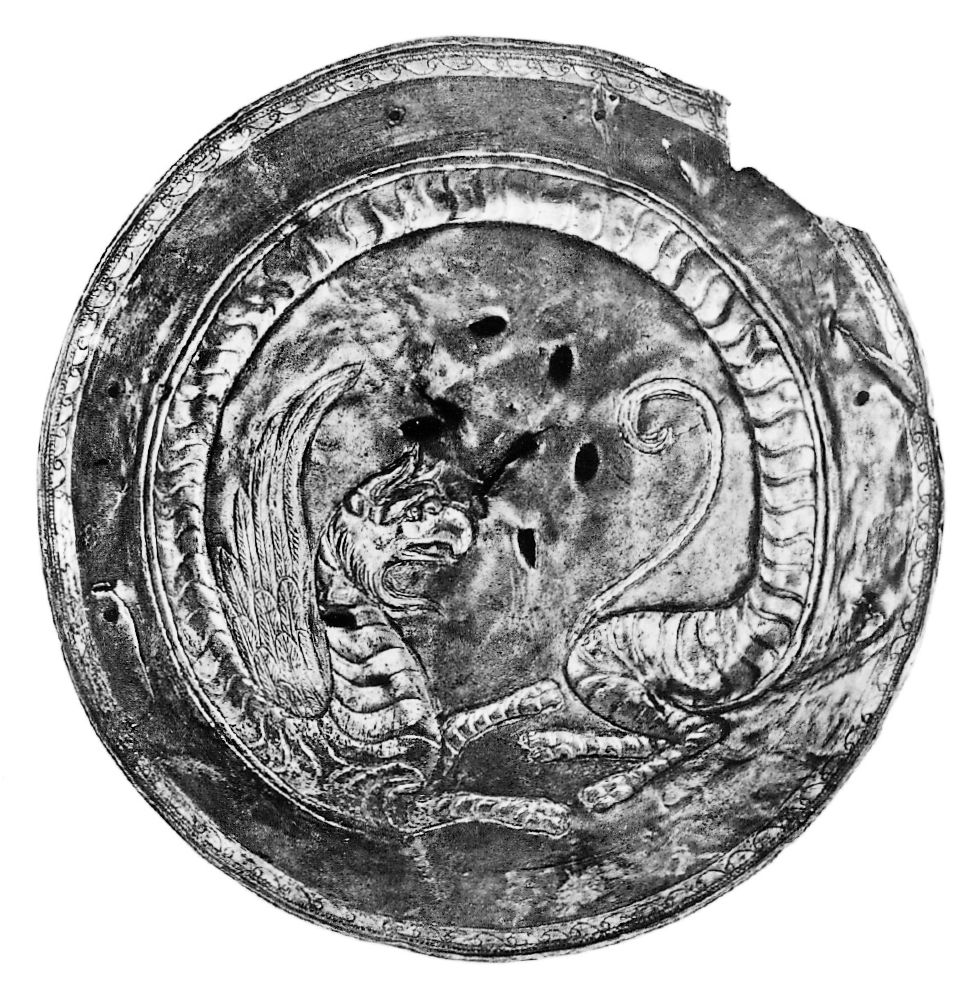
Silver gilt phaleron with a stretched griffin, from Novouzensk, St Petersburg, Hermitage Museum, Author: https://erenow.com

Vote @adsactly-witness for Steem witness!
Witness proposal is here:
Go To Steem Witness Page
In the bottom of the page type: adsactly-witness and press vote.

Use small letters and no "@" sign. Or, click here to vote directly!
Thank you!

Marble head of a Parthian queen, late 1st century B.C.E., from Susa, Iran Bastan Museum, Tehran, Author:Darafsh License:CC BY-SA 3.0
In addition, copies of portrait art were found in the Persian area. The marble head from Susa is equipped with a characteristic battle crown, often seen in sculptures found everywhere between Petra and India.
Portrait art experiences orientalization from the third century BC, and it’s especially easy to see in the coins of the Parthian rulers. The coin found near Bokhara depicts on the obverse the Parthian prince with curly hair, another coin- Heracles, and the inscription ΒΑΣΙΛΕΩΣ ΜΕΓΑΛΟΥ ΑΡΣΑΚΟΥ ΦΙΛΕΛΛΗΝΟΣ "Great King Arsaces, a friend of Greeks"

Coin of Andragoras, the last Seleucid satrap of Parthia. He proclaimed independence around 250 BC, Author:http://www.cngcoins.com License:CC BY-SA 3.0

Coin of Mithridates I (R. 171–138 BC). The reverse shows Heracles, Author:http://www.cngcoins.com License:CC BY-SA 3.0
Persian dishes are often silver, in the form of animal heads, with the mouthpiece between the front legs. Under Greek influence, these vessels were made of clay and used like mugs. The collection of dishes presented in the photograph (with unspecified dating and approximate Persian origin) made of silver. The decorations are shallow and placed on the outside of the dishes. Typically greek, is a wavy pattern at the edge. The Bokhara dish was decorated with a floral motif and Dionysian figures. Hemispherical bowls of this kind were also found in St. Petersburg and Siberia.

Silver bowl with figures set in a landscape of trees,Tibet 1st/2nd cent. AD (?).(After DCAA),Author:https://erenow.com
The vessel found in Tibet is decorated with the representation of Heracles, which is far from classical and enriched with other exotic figures. Characteristic decorations are soldered to the dish - this technique was not used in the West (Boardman, 1995: 96).

Silver cup with classicizing scenes including Herakles attacking a seated man. 1st/2nd cent. AD (?) St Petersburg, Hermitage Museum, Author:https://erenow.com
Baktria
The Bactrian peoples were related to the Scythians and probably to the inhabitants of the Hindu Kush. Achaemenids used to deport subordinate peoples to this land, so it is not surprising that the presence of Greek influences is strong in Bactria. There is a discussion (Boardman, 1995: 99) about the presence of Greeks in Bactria before Alexander, but archaeological evidence indicates that this country was once a prosperous kingdom with a relatively high standard of living of its inhabitants. The coins found are more evidence of existing trade with the Persians than of Greek influences. However, the Greek satrap Diodotus I managed to create a Greek state in Bactria, which has grown to the southeast from one century to the borders of India.

Map of the Greco-Bactrian at its maximum extent, circa 180 BC, Author: World Imaging License:CC BY-SA 3.0

Corinthian capital, found at Ai-Khanoum, 2nd century BC, Author: World Imaging License:public domain
Hellenization in Bactria is easily discernible. The coins look like designed by Greek artists: a typical Western size, the representation of Greek deities placed on the backs, often equipped with an inscription in the local alphabet.
The city of Alexandria on the Oxus (now Ai Khanoum) founded by Alexander has many features of the Hellenistic city: it had a theatre, a gymnasium and buildings with colonnades typical of Greek cities. Sacred architecture, however, remained strictly oriental in Ai Khanoum.

Greek and Indian flame palmettes. Left: Flame palmette at Didyma, Ionia, c.300 BCE. Middle: Pataliputra capital, India, 3rd c.BCE. Right: Ashoka's Diamond throne, Bodh Gaya, India, 250 BCE, Author: Radomil License:CC BY-SA 3.0

Votive altar with Marsyas, dedicated to the River-God Oxus, from Taḵt-e sangin, Author: Boardman, Diffusion of Classical Art License:public domain
Although some of the sculptures exhibited some orientalising features, the stele and fragments of acanthus are typically Greek. The sculptural production techniques came from areas ranging from Syria to India: stucco was used, often gilding and stucco mixed with clay. An accurate illustration of the presence of the Greeks in the Middle East is the bronze statue of Satire standing on the stone altar dedicated to the river Oxus.
Bactrian dishes, like those from Patria, are also classic in style. Discs with ornamental themes of Greece were found: an elephant ridden by Greeks or a classic Griffin. The plate decorated with elongated griffin comes from Novouzensk, located about 250 km north of the Caspian Sea. (Boardman, 1995, 108).
Greek art developed in the areas of the Middle East and beyond, also in the lands that from the perspective of Greece lay at the edge of the world. At least the world, which met the conquering East Alexander. Works of Hellenic artists were created despite strong local traditions, in particular, Persian. Hellenistic art in Bactria, however, was intended for a narrow Greek minority who exercised power (Boardman, 1995: 108). Nevertheless, this art has become so strong that it has survived in various forms for many centuries - in a new form, but without a Greek identity. Narrative elements in sculpture, floral ornaments, architectural details have found a new context, whether in the sculpture of the Parthians or in the culture of nomads.

Silver gilt phaleron from Novouzensk, featuring a war elephant with turreted howdah and a ketos on the saddle cloth, St Petersburg, Hermitage Museum, Author: https://erenow.com

Silver gilt phaleron with a stretched griffin, from Novouzensk, St Petersburg, Hermitage Museum, Author: https://erenow.com
Authored by @highonthehog
References
Images: sources linked below
Photo: @highonthehog
Boardman, J., The Diffusion of Classical Art in Antiquity, Princeton University Press, Princeton, NJ, 1993
Boardman, J., Greek sculpture: The Late Classical Period, Thames and Hudson, London, 1995
Steele, J., Hellenistic Architecture in Asia Minor, Academy Editions, London, 1992
Green, P., Hellenistic History and Culture University of California Press, 1996
Click on the coin to join our Discord Chat

Witness proposal is here:
Go To Steem Witness Page
In the bottom of the page type: adsactly-witness and press vote.

Use small letters and no "@" sign. Or, click here to vote directly!
Thank you!
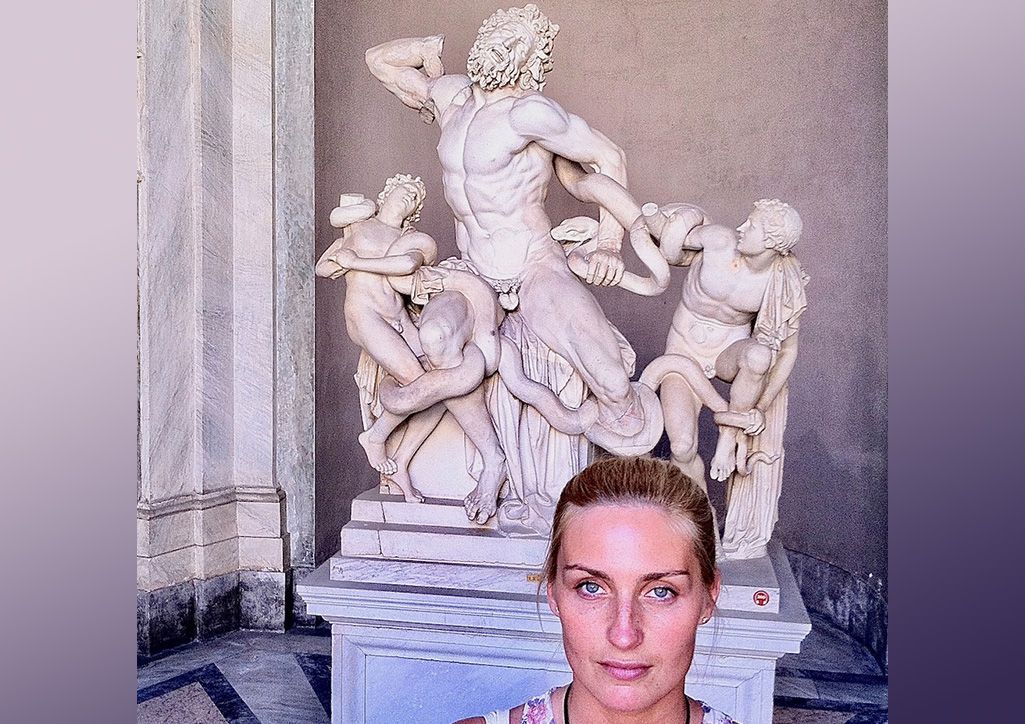



Alexander the Great unified the Greek city-states (with the exception of Sparta who refused to join); he demolished the Persian empire that was threatening Greece for over 50 years (with an army that was well organized yet still 20 times smaller) and went on to conquer a great part of the Middle East and Asia; he then consolidated his new empire with culture rather than force, built tens of new cities (and who can blame him for naming most of them Alexandrias? - the most famous of which being the one in Egypt); and was the only man to conquer and keep Afghanistan (by encouraging intermarrying between his troops and the local population - not by maintaining highly guarded and isolated outposts).
Alexander spread his native Greek language from Egypt to India making it the language everyone spoke for centuries (similar to what English is today) - and this is the reason why, 300 years later, the Gospels and the entire New Testament would be written in Greek and why it was the language favored by scientists and scholars, up until Newton.
Yes, he was born the son of a king and his private tutor was no other than Aristotle. Yet he carved the only Hellenic Empire by military conquest (in contrast, the Byzantine empire was a Hellenic cultural conquest of the Eastern Roman Empire) and changed world history for ever before he was 33.
I would say proud and humbled at the same time.
cool, how about writing a post about it :)
Very nice reply, very informative... Alexander's legacy goes indeed beyond what we usually consider... The Greek East and Latin West portions of the Roman Empire have an unsuspected author in Alexander...
I,m really amazed after reading this post and it helped to understand about history of Alexander. I don,t know that he was such an amazing artist. He contribute that much in art work.
First i only heard about Alexander that he conquer different nations.
Alexander the Great conquered so much territory so quickly that I'm always surprised he was able to maintain control of it as his army pushed further east.
Alexander, for the most part, left things unchanged in the lands he conquered. He didn't impose Greek customs, respected (or perhaps ignored) local religions and cultures and allowed a certain degree of self government that, for several of the territories of the former Achievement empire, was quite a refreshing change. Not everyone under his rule accepted him, but most did, and several satraps capitulated without a fight.
src
Thanks for sharing this amazing post my friend keep going with this passion and help us to increase our knowledge by sharing Informative posts.
Very well written, happy to have you here, thanks for your comment
It’s astounding how these sculptors made arts such as Heracles being created in the rock ridge at Behistun. These details is what amazes me the most. They didn’t use machines or robots to do all this labor. They used golden hands of real craftsmanship. As a matter of fact even today we are appreciating the art of Greek ornamentals. It’s being presented in museums all over the world as well as in the original places, just the way they were created. When I look at these stone sculptures, the details and of course in many cases being naked while not skipping any details, I always wonder “how did they do it, how come this little piece came up so detailed?” Just look at these golden coins. It’s not perfectly rounded, but the face and the reverse side with horses is making it all up. Boy I wish I had one of these. I don’t think I will ever be able to eat from these artistic dishes whether they are made of silver or clay. If I did, I would feel for a moment like a king 😆.
That’s very interesting information. Thank you for this amazing part of history and since I have found something interesting from the history as well, I would like to share it with you. Believe it or not, but this is graffiti style from the first century.

Here is the meaning of first century graffiti.
“Deeds are for the young, counsels for the middle-aged, but farts for the old men.”
(This is authentic and real first century joke)
Great job @adsactly and @highonthehog 👍!
Yes the graffiti looks like from the place where i have lived as a child 😋 actually nearby, this was not the best neighbourhood.
This post really got me hyped. I really love the history of Alexander The Great. He is one of the historical figures I've read a lot about when I was younger. I was really fascinated by him.
I'm so glad I had a chance to read this post because I didn't know a lot of things. It is really educational for me because I didn't know that much of an impact he made on culture. I knew some of the things, but this post got me a lot of new insights, really. I enjoyed reading it from start to the end, it felt like a mini-documentary :D I am glad you provided us with photos so we can see the beauty of it. It's really amazing how people can have an impact on cultures.
Thanks a lot for sharing this with us. It was really amazing and I really learned something that I was already interested in, but you know when life happens, your time just flies away and you don't have time for all of your passions :D
Have a great day @highonthehog!
wow, thank you for your support. I am very happy that you have found my work so inspiring. I also recall many things and learn new ones when I write. And now I enjoy reading intelligent comments such as this one. thanks :)
Haha :D The circle is closed :D ;)
Great detail on how exactly art is influenced by different cultures, in this case, Hellenistic influence on Middle Eastern art and style. I often hear that conquering cultures bring their cultures with them, which in turn influences the lands that were taken, but I hadn't really seen specific examples of how exactly this plays out. This post fills that gap in my knowledge, and then some!
I guess his influence is very telling when the similar style of art is found, as you say, from Persia to India to even Siberia! This wouldn't have developed on its own as each culture had its own distinct culture before, but with the dominating Greeks coming in, their style would influence all cultures they came across... I guess they really liked portraying Heracles in statues or coins or art! Especially without clothing!
Seems like even the dishes they used to eat from can also be used as evidence of the spread of Greek culture and style, the example you give of the dish from Tibet is beautiful yet surprising, I hadn't realized that Greek dominion had penetrated that far. And also your example of the Persian dishes having typically Greek patterns, where I imagine they didn't have them before, are also of interest - Darius the Great must have been rolling in his grave! Looks like only 200 years separated Alexander and Darius unless I'm mistaken...
This is the kind of substance that would be awesome to see in museums; maybe they already showcase this kind of thing, unless say Iran/modern day Persia isn't too keen on illustrating this part of their history haha...
very interesting description! I liked the way you use historical facts. Culture is of great importance in the lives of people from the past and modern people. Throughout history, transformations have taken place in art. You show it to us perfectly. But the same effect was exerted on individual people. The Hellenistic culture was influenced by its great founder - Alexander the Great or Alexander the Great.
This is the man who left his big mark in history. This is a great man of the time that people of the present and future know and will know about. He spread his influence over many lands. The peculiarity of Alexander the Great as ruler was that he accepted the traditions and beliefs of the conquered territories. He did not try to plant his culture and even sometimes left governors and former rulers governors. Such a policy prevented a surge of uprisings of conquered territories. But it every year more and more caused discontent among compatriots. The same system was later used by Roman emperors.
I liked your message. Knowledge of history and art is important for modern people.
Here is something from one of the books i have quoted in my previous works.
"Greeks had to be treated as equal (...). On the other hand, the Asians reacted only to the harsh despotism and only they felt respect from him. (...) [This teaching] Alexander mastered too much. (...) used it for each individual or group (...). - (Green, 1970: 64)
Interesting stuff!...:)...
totally ! ,)
absolute great post on the history of greko roman/greek marble sculpture carving. %100 upvote
So amazing what he accomplished before dying at age 25. Makes me feel old and useless. Hah!
He died around age 32*, so maybe you still got some time!
Hhehehe me too sometimes
I think this is the holy story.It's increasing my power of knowledge.I read this article.
Thanks for reading.